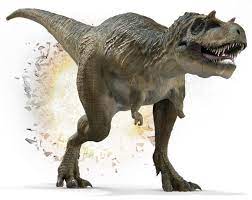Albertosaurus was a large carnivorous dinosaur that lived in North America during the late Cretaceous period, about 70 million years ago. It was closely related to the famous Tyrannosaurus rex, but it was slightly smaller in size, and its skull was more lightly built. Albertosaurus stood approximately 11 to 12 feet tall and was up to 33 feet long. It had a long, deep snout with sharp, serrated teeth, which it used to catch and eat large prey animals such as hadrosaurs and ceratopsians.

Albertosaurus front legs were shorter than its hind legs, and it had a long, stiff tail that helped it maintain balance while running. Like other tyrannosaurids, Albertosaurus had large eyes and excellent vision, which it used to locate and stalk its prey. It was a fast runner, and could reach speeds of up to 25 mph.
Its senses of smell and hearing were also very acute, allowing it to detect potential prey from miles away. Albertosaurus was an apex predator of its environment, and it is thought to have lived in packs. It is believed that these packs hunted together, and that they would work together to bring down large prey. Albertosaurus is an important member of the fossil record, as its remains have been found in several North American locations, including Alberta, Montana, and Wyoming. Its fossilized bones have helped to shed light on the behavior and ecology of the Cretaceous period.
| Name: | Albertosaurus dinosaurs |
| Size: | Approximately 11 to 12 feet tall and was up to 33 feet long. |
| Body: | Albertosaurus had a long, slender head with large eyes and long. |
| Tail: | Albertosaurus had tail was long and flexible. |
| Neck: | Albertosaurus had long neck allowed it to raise its head above tall vegetation to scan for prey |
| Teeth: | Albertosaurus had curved teeth for slicing and tearing its prey. |
| Main Facts: | Albertosaurus is one of the most well-known dinosaurs and its fossils are very common, making it an important part of our understanding of dinosaur paleobiology. |
Albertosaurus was a large theropod dinosaur that lived in what is now North America during the Late Cretaceous period, approximately 70 million years ago. It was a member of the tyrannosaurid family, which also included Tyrannosaurus rex and Gorgosaurus.
The extinction of Albertosaurus is not well understood, and there are several theories about what may have caused it. One popular theory is that a major volcanic event in the Late Cretaceous period may have resulted in a drastic change in climate, leading to the extinction ofAlbertosaurus and other species. Others suggest that a large meteorite impact may have caused the extinction.
The exact timeline of the extinction of Albertosaurus is unclear, but it is thought to have occurred sometime between 65 and 66 million years ago. It is possible that the species survived in isolated pockets until the end of the Cretaceous period, but this is highly unlikely.
The extinction of Albertosaurus is an example of the major loss of life that occurred during the end of the Cretaceous period, when the dinosaurs went extinct. It is estimated that more than 75% of all species on Earth became extinct during this period.
Albertosaurus is a genus of theropod dinosaur that lived in western North America during the Late Cretaceous period, roughly 68 to 66 million years ago. It was one of the last non-avian dinosaur genera to exist before the Cretaceous–Paleogene extinction event.
Albertosaurus is a key species in paleontology due to its close relationship with the famous Tyrannosaurus rex. It is also one of the best known of all theropod dinosaurs due to its abundance of fossil specimens and its geographic range.
Albertosaurus is significant to paleontology for several reasons. First, it is closely related to T. rex, which has become the most iconic dinosaur in popular culture. This means that Albertosaurus can provide insight into the evolution of tyrannosaurids and theropod dinosaurs as a whole.
Albertosaurus abundance of fossil specimens has given paleontologists a better understanding of its anatomy, behavior, and ecology. Finally, its geographic range across western North America has allowed scientists to study the environmental changes of the Late Cretaceous period and the evolution of terrestrial ecosystems in this region.
Albertosaurus is an important species in paleontology, as it provides insight into the evolution of theropod dinosaurs, the Late Cretaceous period, and terrestrial ecosystems in western North America.
Albertosaurus is a genus of tyrannosaurid theropod dinosaur that lived in western North America during the Late Cretaceous period, about 70 million years ago. It is the most well-known of the tyrannosaurs, next to the iconic Tyrannosaurus rex. Albertosaurus was a large predator, measuring up to 10 metres (33 feet) in length, and weighing up to 4 tonnes (4.4 tons). It had a large skull, with a short, curved snout full of many small, sharp teeth. Its eyes were large and its neck was quite short. Its body was muscular and heavily-built, with powerful hind limbs and a long, heavy tail. Its forelimbs were small and weak, and were likely used for grasping prey.
Albertosaurus was an active predator, hunting other dinosaurs, such as hadrosaurs, ceratopsians and ankylosaurs. It may have also scavenged carcasses. Its diet likely included other large dinosaurs, such as its close relative, Tyrannosaurus rex.
Albertosaurus is known from several fossil specimens, including several skulls, various bones, and even a few mummified individuals. It is one of the most well-known dinosaurs, and its fossils are on display in many museums around the world.